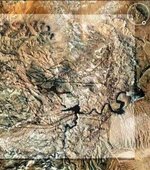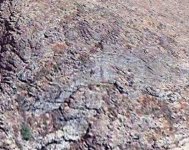somehiker
Silver Member
- May 1, 2007
- 4,365
- 6,434
- Primary Interest:
- All Treasure Hunting
Rather than interrupt Jack H.'s "Map 33" thread, I will re-post the "Minas del Oro" map here for those who may wish to use Google Earth as a virtual means to search for the gold.
Treasure Map Facsimile
If one considers the possibility that the main watercourse has been mistakenly ( or perhaps misleadingly ) labelled "Rio Salado" on this map, and that the river shown may actually be the Gila River, then "Campo Mayor" may also be "Casa Grande".
The Campo Mayor, as drawn on the map, is a good representation of the Casa Grande site (buildings,mound,rectangular enclosure and old diagonal trail) . As is it's position relative to the Gila River. The mound is depicted as a doubled rectangle within the Campo Mayor enclosure.
Orient G/E so that West is up, locate both the "Casa Grande Ruins" Northwest of Coolidge and "Pichacho Peak",26 miles to the East/South East, strike a straight line between the two, then scan the area below the line for whatever might be shown on the map.
Reference to a number of the older historical maps and accounts might also be helpful.
Regards:SH.
Treasure Map Facsimile
If one considers the possibility that the main watercourse has been mistakenly ( or perhaps misleadingly ) labelled "Rio Salado" on this map, and that the river shown may actually be the Gila River, then "Campo Mayor" may also be "Casa Grande".
The Campo Mayor, as drawn on the map, is a good representation of the Casa Grande site (buildings,mound,rectangular enclosure and old diagonal trail) . As is it's position relative to the Gila River. The mound is depicted as a doubled rectangle within the Campo Mayor enclosure.
Orient G/E so that West is up, locate both the "Casa Grande Ruins" Northwest of Coolidge and "Pichacho Peak",26 miles to the East/South East, strike a straight line between the two, then scan the area below the line for whatever might be shown on the map.
Reference to a number of the older historical maps and accounts might also be helpful.
Regards:SH.
Amazon Forum Fav 👍
Last edited:







